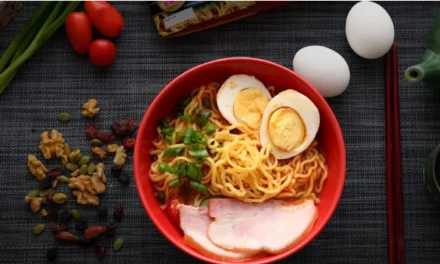Picture yourself strolling through a bustling Seoul market. The aroma of sizzling meat on grills mingles with shouts enticing customers to sample an array of tantalizing street foods. Your eyes catch on a quick-moving queue snaking from a small stall, locals chatting animatedly while munching squash-shaped bites from paper cones. Drawn by curiosity, you peer over shoulders to see an ajumma deftly rolling vibrant ingredients into some sort of spiral log. She slices her creation into coin-like pinwheels, each customer grabbing the treats with greedy fingers. “It’s kimbap!” someone explains, noticing your fascination. But can a Muslim partake in this ubiquitous Korean delicacy? Let’s unravel the answer below.
Defining Kimbap: Korea’s Iconic Rice Rolls
Kimbap (pronounced keem-bahp) makes frequent appearances in Korean dramas, movies and TV shows for good reason—it’s an integral part of culinary culture. These bite-sized rice rolls wrapped in dried laver seaweed fuel locals through hectic weekdays. Kimbap’s portability also makes it a convenient snack on road trips or outdoor activities like hikes.
Its growing popularity abroad means Koreans boast about it the way Americans rave over hamburgers or Italians praise pasta. Yet despite global fans, one question gives many Muslims pause: Is kimbap halal?
A Closer Look at Kimbap’s Main Ingredients
The original kimbap recipe uses just five key components:
- Rice: Short or medium Korean grain rice varieties preferred
- Dried seaweed sheets: Toasted or roasted for extra flavor
- Seasonings: Sesame oil, salt, pepper
- Fillings: Carrots, spinach, eggs, tuna fish, etc.
- Dipping sauce: Soy sauce, rice vinegar, chili paste
Let’s analyze each one more closely regarding permissibility concerns.
Rice – The Sticky Foundation
A base of warm, sticky white rice seasoned with a bit of sesame oil and salt makes most kimbap varieties. Some premium ones might incorporate exotic black rice or whole grains. But short-grain Japonica or Tongil rice cultivated near Seoul is traditional.
Since plain rice and rice flour involve no alcohol or other prohibited ingredients, this kimbap foundation poses no issues from a halal standpoint. That comforting chew comes from higher starch content in Asian varieties compared to dry, fluffy long grain rice more common in the Middle East.
If you ever make kimbap at home, here are a few key tips for fail-proof rice:
- Rinse repeatedly until water runs clear to remove chalkiness
- Use slightly less water than package instructions
- Allow 10-15 minutes steam time once boiling before fluffing
While just rice alone fails to excite tastebuds, once wrapped in savory goodies we soon see how it provides the perfect neutral canvas allowing other flavors to shine.
Gim – The Edible Wrapper
In Korea, various sea vegetables fall under the umbrella term miyeok (미역). Perhaps the most beloved is gim, DRY roasted sheets of laver seaweed. It lends a slate green hue, distinctive ocean-like aroma, and the definitive texture holding kimbap’s fillings securely in place.
Most laver grows off Korea’s southern coastlines orScattergood Channel near China. Temples would traditionally offer this sea vegetable during Buddha’s Birthday and Full Moon Harvest celebrations. Today, gim’s mineral richness still makes it a nutritious addition to breakfast soups, stews, and of course, wrapping snacks.
Laver cultivation methods use no questionable ingredients. Just sunlight, seawater and attentive gathering once plants reach ideal length. Afterwards, open air drying through solar heat gives gim sheets their signature color and savory flavor. From there, manufacturers either:
- Lightly roast unprocessed sheets
- Fry pre-cut strips in sesame oil for extra richness
Either way, nothing about gim seaweed’s origins raise any red flags for Muslim consumers.
Oil and Seasonings – The Flavor Boosters
A few simple seasonings give white rice an appetizing twist before rolling. Usually 1-2 teaspoons toasted sesame oil and a sprinkle of salt. Occasionally a bit of black pepper or beef broth powder sneaks in too.
As long as plain, non-flavored varieties used, sesame oil avoids alcohol and animal extracts during mechanical pressing. Opting for darker roasted types adds even more nuttiness too. Plus, the acclaimed Omega fatty acids and antioxidants in this ancient Chinese secret make sesame oil a superfood studded with healthy fats beneficial for memory, heart health and inflammation reduction.
When it comes to salt, plain sea salt or solar salt avoid additives. Or for a mineral boost, bamboo salt offers a sodium-reduced alternative sustainably baked in cleaned bamboo trunks according to an age-old Korean tradition.
Kimbap Fillings – Exploring Flavor Combinations
The real fun begins when selecting kimbap fillings! Just a thin layer of each ingredient gets spread onto deokbaegim rice paper, then rolled tight into cylindrical logs 3-4 cm diameter. Adventurous eaters mix and match savory, sour and spicy components for flavor and texture contrast. More conservative types stick with familiar veggies and egg combos.
Some classic kimbap fillings might include:
- Bright orange carrot strips for a sweet, crisp crunch
- Slivers of omega-rich fatty tuna, typically preserved in soy sauce or sesame marinade
- Ribbons of pickled daikon radish for tang and bite
- Jade colored spinach leaves wilted just to softness
- Beef bulgogi, Korea’s signature barbecue meat
- Pan-fried egg crepes lending rich creaminess
- Even American favorites like cheese, ham or crab sometimes sneak inside
The produce poses no problem, but meat and seafood must come from properly slaughtered sources. Most Korean eateries will mix non-halal beef and pork on shared surfaces, so home preparation is safest. Tuna also needs verification that no shellfish-based broths touched it during canning.
With a bit of smart substituting though, kimbap becomes easy to adapt for halal diets:
- Vegetarian varieties using mushrooms, kimchi or tofu for protein
- Chicken or beef from verified halal suppliers
- Canned tuna packed in veg broths, olive oil or spring water
- Plant-based ‘cheese’ like soy or cashew varieties
A few odd ingredients like luncheon meat also make occasional cameos in fusion-style rolls. Double check labels since these processed meats probably contain pork. When cooking for Muslims, taking inventive license with ‘halal-fied’ alternatives prevents sacrificing flavor or creativity!
Kimbap Dipping Sauces & Extras
What pairs best alongside kimbap? An array of punchy dipping sauces and banchan side dishes of course! Traditional Korean meal structure balances salty, spicy, sour and sweet elements for flavor equilibrium. So each bite of wholesome rice and veggies finds perfect equilibrium when dunked into umami-rich condiments.
Some mouth-watering kimbap sauce options include:
- Gochujang (고추장) – Sweet and spicy fermented red chili paste
- Ssamjang (쌈장) – Savory miso-gochujang blend
- Doenjang (된장)- Complex fermented soybean paste
- Vinegary soy sauce spiked with wasabi
- Sweet rice wine vinegar with a touch of honey
- Garlicky sesame oil dip
- Simple sesame salt sprinkled on lettuce leaves
The fermentation foundation of many iconic Korean seasonings adds potent enzymes and antioxidants too. As long as no questionable meats or alcohols added in processing, these zesty companions make kimbap even more craveable!
For the authentic experience, don’t forget banchan side dishes like refreshing kimchi, julienned cucumbers or potato salad to offset kimbap’s slight saltiness. Even a bowl of steaming mollakssuksu summer broth goes wonderfully alongside. Construct an edible balance of flavors and textures at home by laying out several Korean banchan with the usual rice and soup.
How Does Kimbap Preparation & Processing Affect Halal Status?
In addition to ingredients themselves, preparation method MUST also follow Islamic guidelines for consuming any dish as truly halal.
Here’s where home-style has clear advantages. Provided all separate elements pass muster, construction poses no issues doing privately in one’s own cooking space. But dining out or buying pre-packaged kimbap does require some caution.
1. Shared food contact surfaces
Korean kitchens often handle both pork and beef on same cutting boards or countertops. Even using separate knives or utensils cannot guarantee no cross-contamination at microscopic levels. So anything with meat/seafood fillings is higher risk ordered at restaurants.
2. Alcohol usage
Some cooks add mirin, sake or other rice wines during kimbap prep too. Always good to ask whether rice got spiked with extra flavor from non-halal alcohols.
3. Food handling hygiene
As with any culinary culture, practices range from meticulously sanitary to alarmingly dirty. Especially outdoor markets or street vendors with high volume traffic and turnover. Check that separate gloves get used for handling halal ingredients. Or better yet, cook up your own bountiful kimbap spread so no doubts about integrity!
4. Unknown ingredients in processed varieties
Mass-produced kimbap sold at convenience marts or grocers may list basics like carrot and egg. But other odd additions or obscure interact quite commonly to lower costs. Without transparent labeling or contacting manufacturers directly, it is near impossible to guarantee no chicken/beef extracts, shellfish-based broth powders or other sneaky ingredients contaminating fillings. So check carefully or stick to making everything yourself for full control.
Tips for Enjoying Certified Halal Kimbap in Korea
Don’t let all those precautions above dissuade visiting foodies though! While straying outside one’s comfort zone culinarily when traveling abroad poses challenges, a few smart guidelines make enjoying true halal Korean fare quite possible:
- Search apps like Halal Gems, Halal Trip or SalamWeb for certified restaurants. Major cities like Seoul and Busan have plenty, often with dedicated prayer rooms too!
- Carry a small cooler bag and make pitstops at grocery stores for versatile fresh ingredients. Then picnic in parks nearby attractions.
- Plan homestays, AirBnbs or hostels with kitchen access to prepare your own food.
- Politely verify with staff on meats, broths and alcohol use when ordering. Have key allergen terms handy.
- Specify needs when booking group tours. Reputable companies accommodate restrictions.
- Don’t be shy asking questions! Open communication makes for enlightening cultural exchange.
Oh, and pro tip? Bibimbap with beef bulgogi and assorted banchan makes another fantastic Korean dish that morphs easily to halal guidelines. Island getaways boasting fresh fish like mackerel or cod also offer culinary reprieve from the usual chicken and lamb options back home.
A Final Kamsahamnida for Halal Kimbap!
While navigating less familiar cuisine customs abroad poses unique obstacles for Muslims, it is doable with some preparation. For Koreans, food equals love and sharing tasty eats with others represents the ultimate gesture of affection and bonding. Halal variations of classics like kimbap demonstrate that Islamic values need not hamper partaking in meaningful cultural connections around dinnertime.
So don’t miss out on iconic street food snacks! With clean ingredients and conscientious handling, Koreans and multi-cultural foodies together can relish these morsels. Gwangjang Market’s kimbap ajummas welcome all to savor springy rice logs filled with authentic local flavor. Grab a tray of their alluring rolls on your next visit to Seoul. You won’t regret it!
Frequently Asked Questions: Is Kimbap Halal?
Traditional Kimbap often contains non-halal ingredients such as ham or fish cakes. However, it is possible to make a halal version of Kimbap by using halal-friendly ingredients such as chicken, beef, or vegetables.
What is Kimbap?
Kimbap, also known as gimbap, is a popular Korean dish made by rolling cooked rice and various ingredients, such as vegetables, meat, and eggs, in dried seaweed sheets.
Can you provide an easy halal kimbap recipe?
Yes, you can create a halal-friendly Kimbap by substituting non-halal ingredients with halal alternatives, such as using chicken instead of ham or fish cakes.
What are some popular Korean desserts?
Some popular Korean desserts include rice cakes, Korean pancakes (hotteok), and various sweet treats made with ingredients like red bean, honey, and sesame.
Where can I find delicious Korean food?
Delicious Korean food can be found in Korean restaurants, food markets, and specialty grocery stores that cater to Korean cuisine.
Is Kimbap a go-to dish in South Korea?
Yes, Kimbap is a popular go-to dish in South Korea, commonly enjoyed as a convenient and satisfying meal or snack.
What are some common ingredients used in making Kimbap?
Common ingredients used in making Kimbap include seasoned rice, vegetables (such as carrot, cucumber, and radish), eggs, and a sheet of dried seaweed.
What is the significance of sesame in Korean cuisine?
Sesame is a widely used ingredient in Korean cuisine, prized for its nutty flavor and aroma. It is often used to season rice, sauces, and various dishes.
How is Kimbap different from sushi?
While Kimbap and sushi share some similarities, such as the use of rice and seaweed, they differ in terms of ingredients, flavors, and preparation methods. Kimbap is often more heavily seasoned and contains a variety of cooked and pickled ingredients.
What are some must-try Korean foods for visitors to Seoul?
Some must-try Korean foods for visitors to Seoul include bibimbap, bulgogi, tteokbokki, hotteok, and of course, Kimbap. These dishes offer a taste of authentic Korean flavors and culinary traditions.





